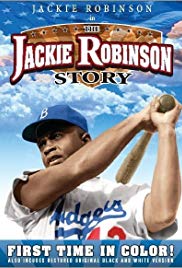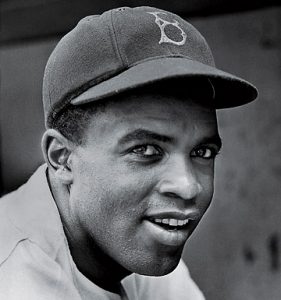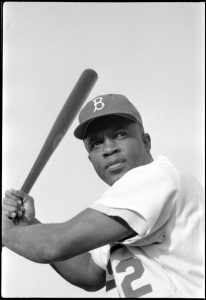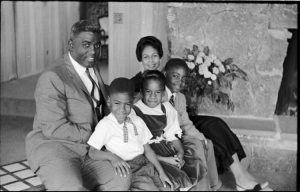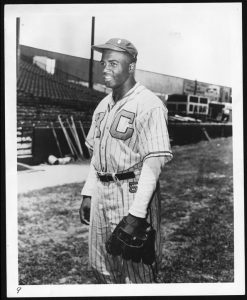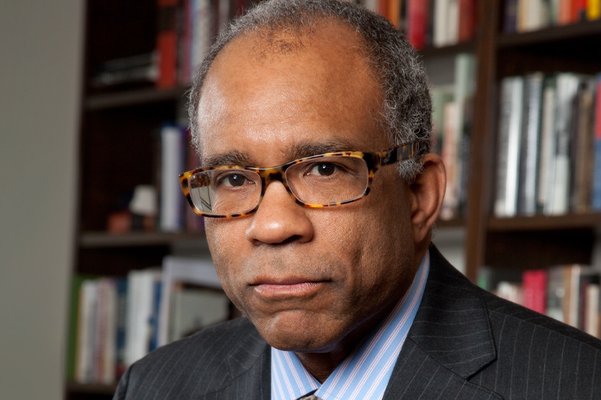In 1945, Robinson broke the color bar against blacks in baseball by signing with the Brooklyn Dodgers organization. He spent the 1946 season with its farm club, the Montreal Royals. In 1947, with the support of Branch Rickey, the legendary manager of the Dodgers, Robinson began playing with the Dodgers. During his first year in the majors, Robinson batted .297 with 125 runs scored and twenty-nine stolen bases. The Dodgers won the pennant and Robinson won the Rookie of the Year award.
Robinson knew that the first several years in the majors would be tough. Branch Rickey told him he’d have to turn the other cheek and not fight back for at least three years. His white teammates got up a petition to keep him off the team. Pitchers threw at him. Base runners dug their spikes into his shin. “Fans” yelled racial epithets and asked him to carry their bags and shine their shoes. Others threw trash, tomatoes, rocks, watermelon slices, and Sambo dolls at him. But Robinson persevered. In 1949, he was selected as the most valuable player in baseball. His lifetime batting average was .311 and he was a daring base runner. Robinson retired in 1957 after helping the Dodgers with six pennants and one World Series. He was elected to the Baseball Hall of Fame in 1962.
These were not all of Robinson’s contributions to baseball. He inspired a generation of black ball players: Hank Aaron, Roy Campanella, Monte Irvin, Willie Mays, Ernie Banks, Frank Robinson, Bob Gibson and others. Listening to Robinson’s speeches and following in his footsteps, they played as if they were on a mission. Nor did Robinson complaisantly accept the role that the major leagues had set out for him. He pushed an often reluctant sport for more opportunities for blacks. Hank Aaron notes that Robinson “campaigned for baseball to hire a black third-base coach, then a black manager. In 1969 he refused an invitation to play in an old-timers’ game at Yankee Stadium to protest the lack of progress along those lines.” Time Article: Jackie Robinson He thrilled fans, shattered baseball’s color barrier and changed the face of the nation, written by Henry Aaron.
All of this would have been more than enough for one man, but Jackie Robinson wasn’t just a baseball player. When he retired from baseball he went into business, becoming a Vice President of Chock Full O’ Nuts, a national coffee and restaurant chain. Later he co-founded Freedom National Bank of Harlem serving as Chairman of its Board from 1964 to 1972. 1970 saw the organization of the Jackie Robinson Construction Corporation. Robinson’s efforts in banking and construction were aimed toward improving living conditions for black Americans, especially those living in the major metropolitan areas.
Throughout his career in business and in sports, Robinson supported the struggle for civil rights. He traveled extensively to raise funds for the NAACP and developed close relationships with Dr. Martin Luther King, Jr. as well as other prominent civil rights and political leaders. Recognizing the strong support that the American Jewish community had given to the Civil Rights Movement and the fact that respect for one minority leads to respect for all minorities, Robinson also supported the Anti-Defamation League of B’nai Brith. In 1956, the NAACP awarded Robinson its highest award for achievement by an African American, the prestigious Spingarn Medal.
What was Jackie Robinson’s unique contribution? After all, Joe Louis, the boxing heavyweight champion had shown that a black man could defeat whites. There are several good answers. Here are two. Jackie Robinson not only showed the blacks could compete against whites, he showed that they could compete with whites, together on the same team. In addition, by answering the epithets and trash hurled at him with dignity and kindness, he showed how mean-spirited and disgusting racism was.
Robinson died in 1972, having helped to change his country for the better and leaving a rich legacy for us all.

